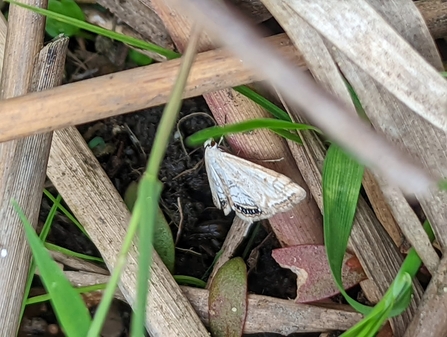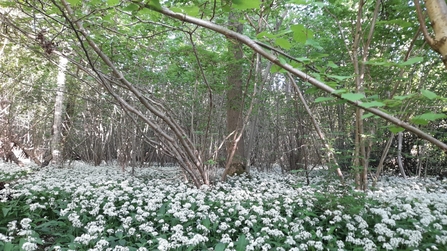Weekly wild news from our reserves - 13 May 2022
Wild garlic at Bradfield Woods – Alex Lack
A poplar hawkmoth, a pale tussock and treble lines have been recorded at Lackford Lakes this week. Visitors will get an opportunity to see moths and learn about bats and other nighttime wildlife during Lackford Lakes’ twilight safari event on Thursday 19th May.
And at Church Farm, a nut-tree tussock and a sharp angled peacock moth were recorded by Warden Dan.
Ringed China-mark
This ringed China-mark moth was recorded at Dingle Marshes. This moth is unusual as their larvae live and feed on aquatic vegetation such as pond weed.

Ringed China-mark moth – Jamie Smith
Cuckoo calling
Warden Lewis said that this cuckoo at Carlton Marshes sounds as if it might have a caterpillar stuck in its throat for the second half of its call! It's been heard on the reserve for a couple of weeks now, and often ends the call in this unusual way.
Darsham path cut
The cows seemed to protest at their grass being cut when the team mowed paths at Darsham Marshes this week! The team were rewarded for their hard work with these gorgeous scenes, and wonderful birdsong.
Wild garlic
Bradfield Woods smells delicious and looks stunning with wild garlic this week. Millions of bulbs may exist in one wood, causing the white, starry carpets and strong garlic smell we so keenly associate with this flower. Wild garlic attracts the attention of plenty of pollinating insects, including hoverflies, butterflies and longhorn beetles.

Wild garlic at Bradfield Woods – Alex Lack
Wangford Warren
Wangford Warren is a living example of the sheer diversity of habitats that Suffolk has to offer and a unique chance to see the inland sand dunes that once washed across this part of the county. The panorama of mounds and dunes – now stabilised by sand sedge – together with grazed grass and open disturbed soil are home to several rare specialist plants including grey hair-grass, shepherd’s cress, bearded fescue and reindeer moss.
Wilding rewards
Once an arable farm, we have been letting nature take the lead for over 20 years at Black Bourn Valley. The results are spectacular, with an impenetrable thicket of hawthorn, blackthorn and dog rose in some areas – perfect for blackcap and other warblers in summer and flocks of redwing and fieldfare in winter. In open grassy patches early marsh, pyramidal and common spotted orchids have sprung up of their own accord as well as plants such as common centaury and marsh marigold. The scrub has attracted both turtle dove and nightingale, both of which have been heard calling this week.
Grass snake
This grass snake took a short cut between Carlton Marshes and Oulton Marshes and swam the Oulton Dyke this week. It struggled to climb the pilings when it got there, but eventually found a way.














